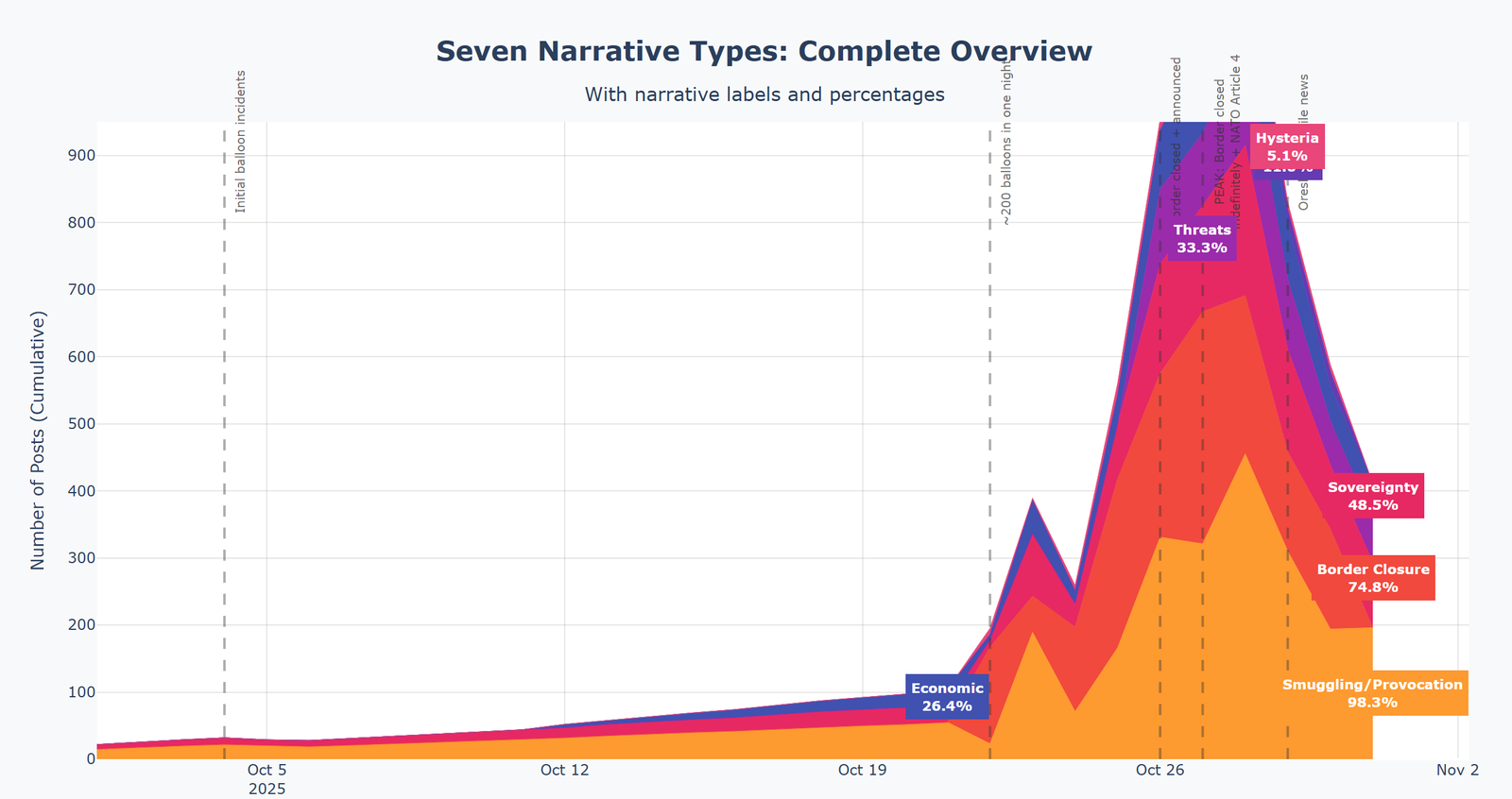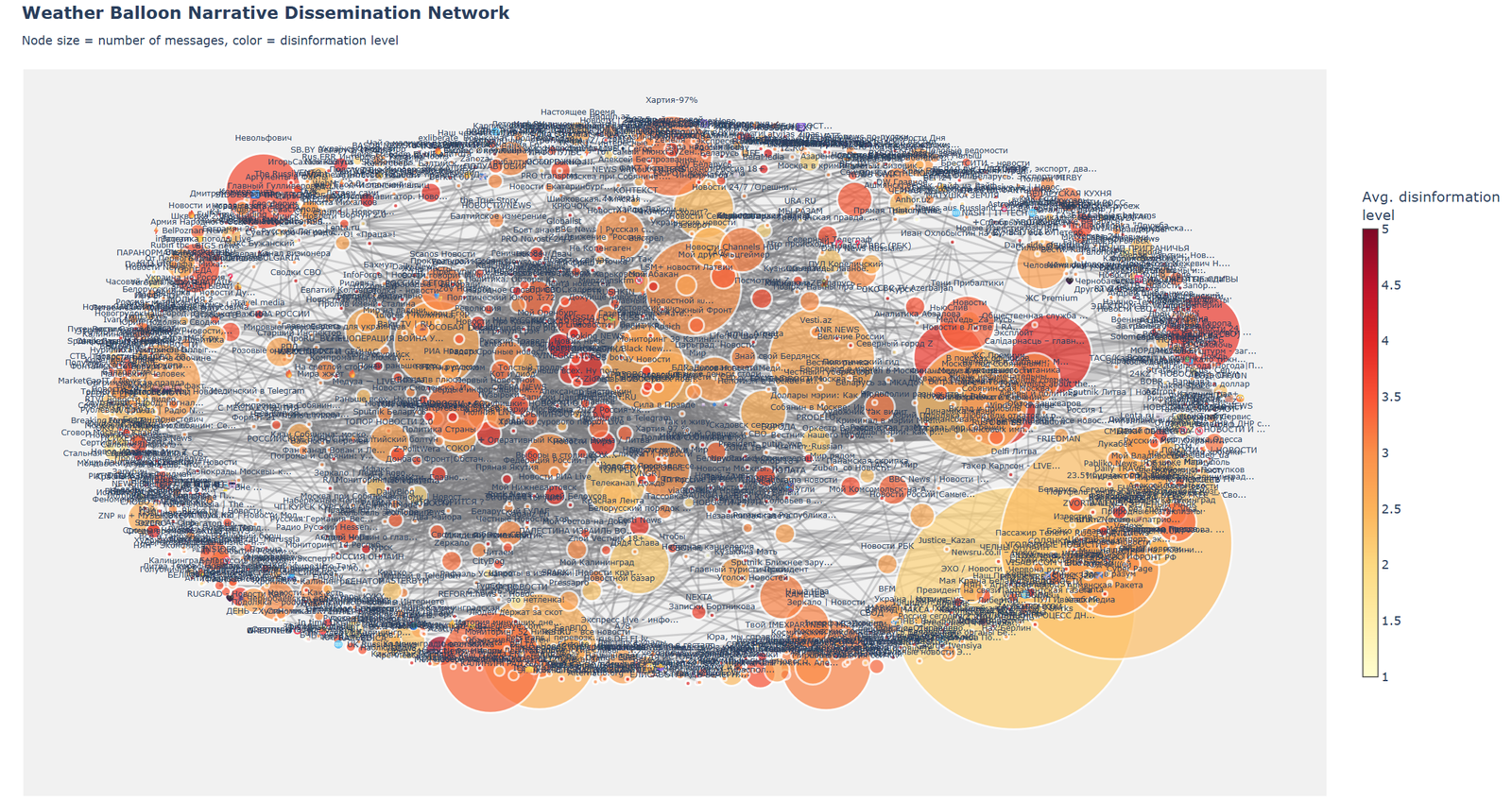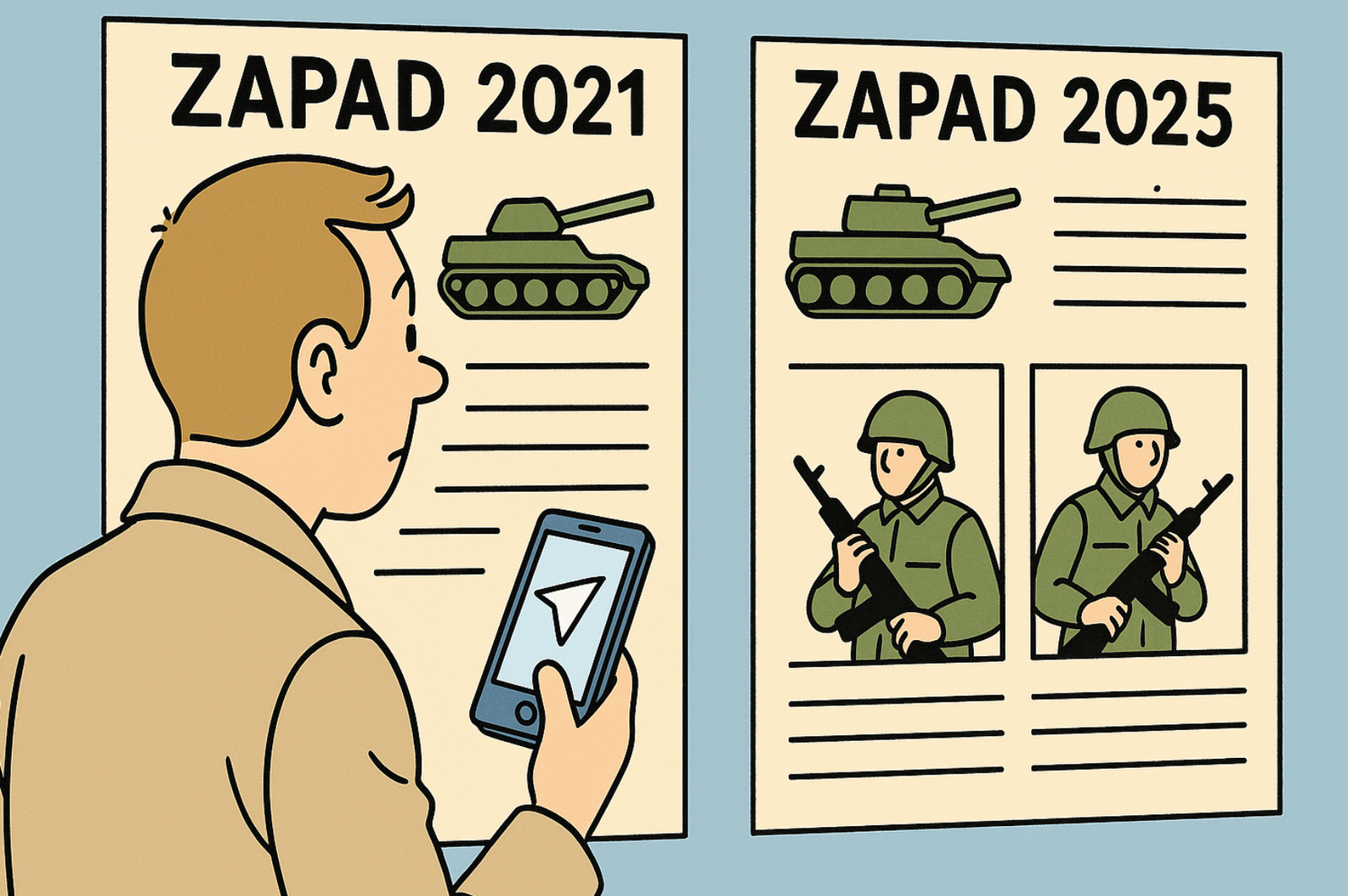Today we’re reviewing the campaign as of October 30, 2025. The story is still evolving and will require updates as new events unfold.
Summary / TL;DR
On October 4, 2025, the first hot air balloons carrying contraband cigarettes took off from Belarus into the skies over Lithuania. It seemed like a local crime story. But that very night, Vilnius Airport was forced to close its airspace for the first time due to 13 weather balloons approaching air routes. Direct losses amounted to €14,500.
On October 22, the situation escalated sharply: in one night, about200 balloonsThe airport closed again, disrupting eight flights. That same morning, Lithuanian authorities made an unprecedented decision to temporarily close both checkpoints on the border with Belarus.
On October 24, weather balloons were once again heading to the airports. Vilnius and Kaunas airports were closed until 2 a.m. The border was also closed again. By the morning of October 25, the airspace had already been disrupted.40 flightsThe border reopened briefly—that same evening, a new wave of weather balloons led to the reclosure of both the airports and the border.
October 27th marked the culmination of the crisis. Within a week,more than 170 flights, 27,000 passengers were affected, and airport losses exceeded €81,000. Lithuanian President Gitanas Nausėda proposed “permanently closing the border with Belarus and restricting transit to Kaliningrad.” The Prime Minister announced the possibility of activatingArticle 4 of NATOThe border was closed “for an unlimited period of time.”
On October 29, the government formalized its decision: the border is closing.until November 30Bus service to Minsk has been suspended. Hundreds of Lithuanian trucks are stranded in Belarus.

Full interactiveschedule.
But in parallel with real events, another story was unfolding in the information space. OurAnalysis of 2,601 publications in 1,227 Telegram channelsshows signscoordinated information operation: with a 6000% increase in activity, simultaneous publications at 364 points in time, and seven types of mutually reinforcing narratives – fromLithuania is hystericalbefore“Lithuania threatens Russia”.
How a smuggling incident turned into an information war with military rhetoric—in our data-driven investigation.
METHODOLOGY
From October 1 to October 30, 2025, we collected and analyzed2601 publications from 1227 uniqueTelegram-channelsThese are Russian-language channels covering events in Lithuania: from Belarusian state media to toxic pro-Kremlin Telegram channels, from official Russian publications to independent Baltic media.
The methodology is simple: we recorded the time of each publication.accurate to the minute, extracted all mentions of Lithuania, categorized the narratives, and measured the toxicity of the content. The results were revealing.
Key metrics
91.3%All publications mention Lithuania. This isn’t just news coverage of weather balloons—it’s a targeted focus on Lithuania as the subject of an information campaign.
From 15 to 235 posts per day— such is the growth trend. During the first week of October, the weather balloon story was covered quietly: 15-30 posts per day, mostly technical reports on the facts. During the last week of October, there were 180-235 posts daily, with politicized, often toxic content.
419 publications— the absolute peak occurred on October 27, the day Lithuania announced the indefinite closure of its border and the president spoke of possible restrictions on transit to Kaliningrad.
364 momentstime when two or more channels published postsat the same minuteThis is not an accident. It is a sign of coordination.
To quantify the nature of the information operation, we used the FIMI Score system, a standardized methodology for analyzing foreign information interference.

Each of the 2,601 publications was assessed on six parameters on a scale from 1 to 5:
Disinformation— the presence of factual distortions, false claims, or contextual manipulation. The distribution shows a peak at level 3 (1,232 posts), indicating a moderate level of outright disinformation while maintaining a semblance of credibility.
Emotional manipulation— the use of emotionally charged language, dramatization, and the provocation of fear or outrage. The peak at level 4 (1,372 posts) demonstrates a high degree of emotional content manipulation, which is typical of information operations aimed at eliciting an emotional response rather than rational analysis.
Anti-Lithuanian orientation— the degree of hostility or delegitimization toward Lithuania, its authorities, or its actions. The peak at level 4 (1,266 posts) confirms that the overwhelming majority of the content bears a clear anti-Lithuanian bias, beyond critical analysis.
Pro-Kremlin position— the degree of support for Russian or Belarusian narratives. Interestingly, the peak is at level 2 (1,696 posts), indicating moderate pro-Kremlin rhetoric. This may be explained by a “gray zone” strategy—avoiding direct propaganda in favor of more veiled forms of influence.
Coordination— signs of coordinated action across channels (simultaneous posts, identical content, synchronized narratives). A peak at level 3 (1,820 posts) indicates moderate but consistent coordination of most content.
Threat level— an integrated assessment of the publication’s potential damage to national security and public discourse. A peak of 4 (1,903 posts)—the highest among all metrics—indicates that the information campaign poses a serious threat to the target country.
Average values for all metrics:
- Misinformation: 3.0/5
- Emotional Manipulation: 3.7/5
- Anti-Lithuanian bias: 3.6/5
- Pro-Kremlin position: 2.1/5
- Coordination: 3.0/5
- Threat Level: 3.8/5
The combination of high emotional manipulation (3.7), anti-Lithuanian bias (3.6) and threat level (3.8) with moderate pro-Kremlin rhetoric (2.1) is typical of “gray” information operations, where direct attribution is difficult, but the effect of delegitimizing the target state is achieved through multiple indirect narratives.
FIVE PHASES OF ESCALATIONThe information campaign developed in stages, parallel to real events, but with a characteristic preemptive and intensified pace.

Phase 1: Technical Information (October 1-21)
Volume:15-30 posts per day
Key:Neutral
Narratives:Technical Fact Reports
Weather balloons did indeed appear sporadically during the first three weeks of October. About 10 balloons were discovered in various parts of Lithuania. The information was presented as a crime report: smugglers are using a new method to smuggle cigarettes.
Delfi Lithuania reported technically on October 6: “The head of the National Crisis Management Center, Vilmantas Vitkauskas, reported that more than 10 weather balloons that had flown from Belarus to Lithuania were found.” Authorities discussed tougher penalties for possession of contraband.
Russian-language Telegram channels repeated the information without much comment. Toxicity was virtually zero. That was the background.Phase 2: Mass Incident (October 22)
Event:~200 weather balloons in one night
Volume:193 posts (a 6-fold jump)
Key:Transition from technical to political
New narratives:Discussions about border closures are emerging.
A qualitative change occurred on October 22. Delfi Lithuania reported: “Vilnius Airport operations were disrupted again due to weather balloons. This affected eight flights in the evening and overnight.” That same morning: “Both checkpoints on the border with Belarus were closed for security reasons.”
Telegram began to politicize. Instead of “weather balloons detected,” phrases like “Lithuania closed the border because of balloons” and “Lithuania is exaggerating the threat” appeared. The number of posts increased from 30 to 193 in 24 hours.Phase 3: Border Closure (October 24-26)
Events:Repeated airport and border closures
Volume:154-294 posts per day
Key:Critical
New narratives:“Lithuania is overreacting,” “Economic damage,” “Threats to Kaliningrad”
On the night of October 24, Delfi reported: “Vilnius and Kaunas airports in Lithuania were suspended until 2 a.m. Checkpoints on the Lithuanian-Belarusian border were closed.” On October 25: “At both airports, 40 flights were cancelled, delayed, or diverted due to weather balloons.”
The border opened and closed three times in three days. Each closure reinforced narratives in the media.
On October 26, President Nausėda spoke publicly for the first time about tough measures: “Among the options being discussed are a long-term closure of the border with Belarus and restrictions on transit to Kaliningrad.”
Exactly.October 26A new narrative has emerged in Russian-language Telegram channels:Threats to Kaliningrad. This narrative had never been seen before. After the president’s statement, there were 63 posts a day for the following week. Growth from zero isinfinite percentage, but in fact we are talking about growthfrom 0 to 63 posts per day.
Phase 4: Peak of Outrage (October 27)
Events:Announcement of permanent border closure
Volume:419 posts (absolute peak)
Key:Aggressive
All narratives reach their peak
October 27th was a day of information explosion. Delfi documented the reality: “Over the past week, Lithuanian airspace has been closed four times due to smuggled weather balloons launched from Belarus. More than 170 flights have been disrupted, and 27,000 passengers have been affected.”
Prime Minister Inga Ruginienė stated: “The border with Belarus will be closed indefinitely.” Furthermore, “We do not rule out the possibility of considering activating NATO’s Article 4 and initiating consultations with allies.”
This was a turning point—and it was this that triggered the most powerful reaction in the information space.
419 publications in one day, of which: – 411 about “smuggling/provocation” – 264 about “border closure” – 170 about “threats to Kaliningrad” – 50 about “military context”
All seven types of narratives peaked simultaneously. This isn’t an organic reaction to the news. It’s a coordinated intensification.
Phase 5: Military Escalation (October 29-30)
Events:Border closure formalities + news about the Oreshnik missiles
Volume:180-200 posts per day (maintained at a high level)
Key:Military rhetoric
New frame:Connection to the Deployment of Missiles in Belarus
On October 29, the Lithuanian government officially approved the border closure until November 30. Delfi: “The government decree provides for the closure of the Medininkai and Šalčininkai checkpoints.”
However, on the same day, a new topic emerged in the media: the deployment of Russian Oreshnik medium-range missiles in Belarus. This was a separate news item, not directly related to the weather balloons. However, two threads appeared on Telegram channels.intentionally tied.
Publications like “Oreshnik” in Belarus: A Cold Signal to the West and “Minsk Again Becoming the Center of the Geopolitical Chessboard” have appeared.
The weather balloon narrative has reached a new level—from crime and the border tomilitary escalation and missiles.
On October 30, activity continued. That evening, Delfi again reported: “At 8:10 PM, Vilnius Airport was temporarily closed.” Weather balloons continued to fly, but the information campaign had already firmly linked them to a global military confrontation.
SEVEN TYPES OF ATTACKAn analysis of 2,376 publications mentioning Lithuania showedseven different narrativesImportant: these aren’t separate stories. They’re a single, multi-layered campaign, where each narrative reinforces the others.

Narrative 1: Smuggling/Provocation (98.3%, 1999 posts)
The gist:“These are just cigarette balls. Lithuania is exaggerating.”
Key phrases:– “About 200 weather balloons carrying contraband cigarettes landed in Lithuania” – “Lithuania closed its airport due to dozens of hot air balloons” – Without the word “threat,” the emphasis is on “cigarettes”
This narrative is presentin almost all publications(98.3%). It forms the foundation: what Lithuania calls “airspace violations” is, in fact, simply smuggling, a mundane problem that doesn’t merit political action.
Height:From 15 posts/day (first week) to 235 posts/day (last week) =+1,338%
Narrative 2: Closing the border is too much (74.8%, 1,520 posts)
The gist:“Lithuania is reacting inadequately by closing the border because of the balloons.”
Key phrases:– “Lithuania closed border crossings with Belarus for the second time in a week” – “Lithuania closed the border because of balloons” – “The Lithuanian Prime Minister announced the closure of the two remaining border crossings until Saturday afternoon”
This narrative appearedOctober 22, coinciding with the first border closure. Before that, there were 5-6 posts per day. After October 22, there was a jump to 169 posts per day by the end of the month.
Height:From 6 posts/day to 169 posts/day =+2,428%
The peak occurred onOctober 26-27, when the government announced an indefinite closure. During these days, the narrative of “excess” appeared in 264 publications.
Narrative 3: Violation of sovereignty is an exaggeration (48.5%, 987 posts)
The gist:“Lithuania is being dramatic when it talks about airspace invasion”
Key phrases:– “Vilnius protested to Minsk over airspace violations” – “About 200 hot air balloons violated the country’s airspace” – Emphasis on the word “balloons,” not “unmanned aerial vehicles”
Interesting feature:neutral channelsthey are simply reporting the facts (“Lithuania accuses Belarus of violating its airspace”),pro-Kremlin channelsadd doubt (“Lithuania claims”, “Lithuania states”), andtoxic channelsThey openly ridicule it (“because of the balloons”).
Even the dry statement of fact, repeated 987 times, creates the impression that if there’s so much talk about the “violation,” then Lithuania must be exaggerating.
Narrative 4: Threats and Sanctions – Lithuania Threatens Russia (33.3%, 678 posts)
The gist:“Lithuania is using the incident to threaten Kaliningrad and demand sanctions.”
Key phrases:– “The President of Lithuania proposed restricting transit to Kaliningrad” – “The President of Lithuania, Gitanas Nausėda, proposed closing the border with Belarus or restricting transit to the Kaliningrad region”
Thiscritical narrative, because heturns the situation around: from an object of action (Lithuania reacts to weather balloons) Lithuania turns intosubject of threats(Lithuania threatens Russia).
Height:From 0 posts/day to 63 posts/day =+6,329%(Formally, infinity, since growth is from zero)
This narrative emergedOctober 26, immediately after the president’s statement about the possible restriction of transit to Kaliningrad. Over the course of 4 days (October 26-30),253 posts— more than a third of all publications of this type for the month.
Narrative 5: Economic Damage – Lithuania is Harming Itself (26.4%, 536 posts)
The gist:“Closing the border and airports is detrimental to Lithuania itself.”
Key figures from the publications:– “Weatherproof weather from Belarus has caused 81,000 euros in damage to airports” – “More than 170 flights disrupted, 27,000 passengers injured” – “Hundreds of Lithuanian trucks stuck in Belarus”
The paradox of this narrative:the numbers are realDelfi did indeed report losses at airports (81,000 euros), stranded trucks (hundreds), and passengers (27,000).
Butcontext changes meaningLithuanian media presents this ascosts of defending sovereigntyYes, there are losses, but security is more important. Pro-Kremlin channels are reporting it asproof of the authorities’ stupidityLook how much they lose because of their hysteria.
Same facts, different interpretations.
Narrative 6: Military context – escalation (11.0%, 223 posts)
The gist:“The events are related to the deployment of missiles, NATO, and military escalation.”
Key phrases:– “Nutwood” in Belarus: A Cold Signal to the West – “Minsk is Once Again Becoming the Center of the Geopolitical Chessboard” – “Lithuania Considers Activating NATO’s Article 4”
This narrative emergedlater than the restand has two sources:
- October 27— Statement by the Prime Minister of Lithuania on the possible activation of NATO’s Article 4 (consultations with allies)
- October 29— news about the deployment of Russian Oreshnik missiles in Belarus
These two topicsnot directly related, but in the information space theydeliberately brought togetherWeather balloons → border closure → NATO threats → missiles in Belarus. A linear chain of cause and effect, where each link intensifies the sense of escalation.
Height:From 0.3 posts/day to 13 posts/day =+1,000%
Narrative 7: Hysteria and Panic – Lithuania is Inadequate (5.1%, 103 posts) ⚠️ MOST TOXIC
The gist:“Lithuania has fallen into hysteria, paranoia, and Russophobia.”
Key phrases:– “We demand an end to these provocations! The Lithuanian authorities are once again displaying Russophobic hysteria.” – “Concerns are exaggerated.” – “🤡The sun hasn’t even risen over Vilnius yet, and they’ve already taken down the Minister of Defense.”
Thisthe most dangerous narrative, although its share is small (5.1%). He doesn’t just criticize the actions of the authorities – hedelegitimizes Lithuania’s very ability to adequately assess threats.
If other narratives argue against specific decisions (“why close the border”), this narrative attacksrationalityLithuanian leadership as a whole.
Height:From 0.9 posts/day to 12 posts/day =+592%
Channels promoting this narrative:–Shadows of the Baltics(toxicity 0.82 out of 1.0) – pro-Kremlin channel in the Baltics –YELLOW PLUMS Network— a coordinated group of Belarusian toxic channels –Russian toxic channels(106 channels) with an emphasis on “Lithuania as a NATO puppet”

SIMULTANEOUS PUBLICATIONSCoincidence or coordination?
What we discovered
Analyzing 2,601 publicationsaccurate to the minute, we found364 moments in time, When two or more channelspublished postsat the same minute.
The probability that this is a coincidence approaches zero.
Top 5 moments with maximum coordination
- October 28, 3:10 PM – 10 channels simultaneously
Ten different Telegram channels published posts within one minute: – Financial Literacy and Opportunities – Our City Herald – Novosibirsk-Info – Investments and Profits – Scams and Politics – (and 5 more channels)
All posts were about the economic consequences of the border closure for Lithuania. Same talking points, same timing, different channels.
- October 24, 10:21 PM — 9 channels
Nine channels in one minute: – DailyBlog – NEWS HERE AND NOW – SFERA NEWS – URAZOVO speaks 🇷🇺 – WORLD NEWS – (and 4 more channels)
All about the repeated airport closures on the evening of October 24. The information is fresh (the event occurred at 9:42 PM), but the coordination is obvious.
- October 24, 10:30 PM – 9 channels
Nine minutes after the previous surge, nine channels were broadcasting simultaneously: – Breaking News! – From the First Person | OPL – RSS bot – The first of the first news from Russia, and beyond – Moscow News. First-hand – (and four more channels)
The same news story, but already in a second wave of intensification. Two coordinated publications, nine minutes apart.
- October 26, 6:17 PM — 9 channels
The day President Nausėda spoke about restricting transit to Kaliningrad. That evening, a coordinated response from nine channels took place within a minute.
- October 22, 8:15 AM – 8 channels
The morning after a night of 200 weather balloons. The first border closure. Coordinated coverage of the event: – News | Politics | Media | Emergencies | Events – AVIA-news | Aviation and Tourism News – URAZOVO Speaks 🇷🇺 – WORLD NEWS – Espresso News – (and 3 more channels)
What does it mean
One simultaneous publication could be a coincidence. Two is a coincidence. But364 momentsin 30 days, frommaximum of 10 channels simultaneously— this is not a coincidence.
This is: – Either useautomaticRSS-bots, which instantly duplicate content – Orcoordinated publicationon general signal – Eitherretransmissionfrom a single source
In any case, thisnon-organic news distribution.
Yellow Plums NetworkThe most obvious coordination is the activity of a Belarusian toxic network of channels under a common brand.YELLOW PLUMS.
What is this?
YELLOW PLUMS areecosystem of 16Telegram-channels, working synchronously: – JS Premium – JS VIP – YELLOW PLUMS (main) – JS Elite – JS Gold – (and other variations)
All channels: – Publishidentical content – IN the same time(up to a minute) – Chigh toxicity (0.30-0.40 per post) – C anti-Lithuanian bias
Scale of coordination
Our dataset recorded60-69 simultaneous postsfrom this network’s channels. This is the highest level of coordination among all the groups detected.
Example: on October 27 at 12:00 PM, all 16 channels of the network simultaneously published a post about “Lithuanian authorities’ hysteria” and “border closure due to balloons.” The text is identical, the emojis are the same, even the typos are the same.
Content toxicity
The YELLOW PLUMS network’s channels specialize in:Narrative of hysteria(Lithuania reacts with panic) –Ridicule(emoji 🤡, “clowns from Vilnius”) –Delegitimization(“NATO puppets”)
Moderate toxicity:0.35 per post(where 1.0 is the maximum). For comparison, neutral news channels have a toxicity of 0.05-0.10.
Signs of organization
- Single source of contentAll 16 channels publish identical texts
- Time synchronization: Publications at the same minute
- Unified editorial policy: Same tonality and accents
- Scalability: Content is instantly multiplied across 16 channels
This is not spontaneous news coverage. This iscontrolled amplification network.

INFORMATION THREATS
To understand the nature of what we observe in October 2025, it is important to draw a clear line between two phenomena.
A typical news coverage or PR campaign has a predictable dynamic. Channels react to events as they unfold, activity peaks within the first 24 hours and tapers off after three to five days. The focus remains on the facts of the event, and media outlets operate independently of one another—even when citing common sources, there’s enough time between publications for individual audiences to process the information.
The information operation operates fundamentally differently. Events are used not as a subject of coverage, but as a catalyst for launching pre-prepared narratives. Activity doesn’t decline naturally, but is artificially maintained for weeks. Instead of a single story, a whole complex of mutually reinforcing narratives is promoted, attacking the problem from multiple angles. And most importantly, the actors work not independently, but in a coordinated manner, which manifests itself in synchronized publications and identical content.
Our case unmistakably belongs to the second type.
Goal architecture
An analysis of the seven identified narratives allows us to reconstruct a three-level architecture of the information operation’s objectives.
Ontactical levelThe task is simple and concrete: to delegitimize the actions of the Lithuanian authorities to protect the country’s sovereignty. The closure of airports, the temporary suspension of border crossings, the month-long border closure—each of these decisions must appear unjustified, excessive, and harmful to Lithuania itself.
Onoperational levelThe goal is more subtle: to create and reinforce in the audience’s minds the impression that Lithuania is systematically overreacting and that the real problem is greatly exaggerated. It’s important not just to criticize specific decisions, but to shape the general perception of the Lithuanian authorities as prone to hysteria and inappropriate reactions.
Onstrategic levelThe main goal is to undermine trust in Lithuania’s ability to adequately assess threats to its security. Convincing domestic or foreign audiences that the Lithuanian leadership cannot distinguish a serious threat from an imaginary one will devalue any future statements the country makes about border violations, hybrid attacks, or other forms of pressure.
The Five-Step Mechanics of Delegitimization
The information operation unfolded according to a proven algorithm, where each subsequent step strengthened the effect of the previous one.
The first step— threat minimization. Unmanned aerial vehicles (UAVs) violating airspace and posing risks to aviation are consistently described as “mere cigarette balloons,” “air balloons,” or “weather balloons carrying contraband.” The focus shifts from border violations to the cargo’s contents. Instead of a security threat, it’s considered household contraband.
The second step— criticism of the response. Once the threat is successfully mitigated, any government action automatically appears excessive. “Lithuania closed the border because of balloons,” “airports were shut down because of balloons”—these formulations deliberately emphasize the disparity between the scale of the response and the supposed insignificance of the cause.
The third step— direct delegitimization. Criticism of specific decisions escalates into an assessment of the psychological state of those making them. Terms like “hysteria,” “panic,” “paranoia,” and “Russophobic hysteria” appear. The Lithuanian authorities are portrayed not simply as mistaken, but as emotionally unstable, incapable of rational decision-making.
Step four— a role reversal. This is the critical moment when Lithuania transforms from the object of actions to their subject. The country whose border is being violated suddenly becomes the aggressor: “Lithuania is threatening Kaliningrad,” “Lithuania is demanding sanctions against Belarus,” “Lithuania is provoking escalation.” A defensive reaction is renamed an offensive action.
Step Five— expanding the context to its maximum extent. A local incident is linked to global processes: the deployment of missiles, the standoff between NATO and Russia, and military escalation in Europe. Weather balloons become not the cause, but merely a pretext in a larger geopolitical game, in which Lithuania plays the role of provocateur.
As a result of this sequence, the original event—the actual airspace violation—is completely relegated to the background. The carefully constructed image of an “inadequate Lithuania” that is causing its own problems and threatening its neighbors comes to the fore.
Three target audiences
The information operation was designed to simultaneously impact different audiences, taking into account their specific characteristics.
Lithuanian audienceThe goal here is twofold. First, to sow doubt even among those who generally trust their government: “Maybe the authorities are really overreacting this time?” “Couldn’t the problem have been handled more gently?” Second, to create fatigue with the issue by artificially inflating it. By the end of the month, even objective information about new incidents is perceived as “these weather balloons again, enough of this.”
Russian audienceHere, the narrative of “Lithuanian aggression against Kaliningrad” and unfounded threats to the vital Russian exclave is being vigorously promoted. The goal is to create information grounds to justify any future retaliatory measures. If Russia takes any action against Lithuania, Russian audiences will have a ready-made explanation: the country is defending Kaliningrad from Lithuanian provocations.
Belarusian audienceHere, the narrative is even simpler: neighboring Lithuania is behaving hysterically and inappropriately, while Belarus remains an island of stability. The contrast is deliberately heightened: “hysterical Lithuania” versus “calm Belarus,” “Western provocations” versus “Minsk’s reasonable policies.”
Measurable consequences
Information operations are not an abstract threat. They produce concrete, measurable effects.
Blurring the perception of threatIt happens through repetition. When thousands of posts from various sources repeat the formula “they’re just balls with cigarettes,” a significant portion of the audience begins to accept it as an established fact. Even those who initially understood the seriousness of the situation, under the pressure of the information flow, begin to doubt: maybe they’re exaggerating? Maybe it’s not such a big problem?
Tired of the topicThe artificial inflated informational noise is the source of this fatigue. By the end of October, any mention of weather balloons provoked a rejection reaction from some audiences: “This topic again, I’m sick of it.” The paradox is that fatigue is created not by the events themselves, but by their informational amplification. As a result, even legitimate information about ongoing border violations is met with indifference or irritation.
Preparing the information groundFor future events—perhaps the most dangerous consequence. By the end of October, the narratives “Lithuania is to blame” and “Lithuania threatened first” were already ready and circulating in the information space. If any escalation occurs in the future—new border restrictions, incidents with Kaliningrad transit, any form of pressure on Lithuania—these narratives could be activated instantly.
MAIN CONCLUSION
This is a coordinated multi-layered information operation., using a real incident (weather balloons) ascatalystto promote multiple anti-Lithuanian narratives.
From October 4 to 30, 2025, real events unfolded along one trajectory, while the information space followed a different one.
In reality, weather balloons carrying contraband cigarettes did indeed cross the Lithuanian border, posing a threat to aviation security. Lithuanian authorities responded consistently: airports were closed while the unmanned objects passed, and the border was first temporarily closed, then for a month. The losses were measurable and documented: €81,000 in direct airport losses, 170 disrupted flights, and 27,000 injured passengers. At the same time, the Lithuanian government sought technical solutions—from detection systems to ways to neutralize the weather balloons.
In the information space, however, a completely different story unfolded. 2,601 publications in 1,227 Telegram channels created an alternative reality, where activity increased 6,000% in a month. Seven different narratives—from “Lithuania is overreacting” to “Lithuania is threatening Russia”—worked in sync, reinforcing each other. This coordination wasn’t just a metaphor, but a measurable fact: 364 moments in time when two or more channels posted within the same minute. Most notable was the escalation of rhetoric: what began as reports of “balloons with cigarettes” culminated in discussions of the deployment of Oreshnik missiles and military threats.
These two trajectories intersected on October 27. On that day, when the Lithuanian president publicly spoke about restricting transit to Kaliningrad, the information campaign gained new fuel. The focus instantly shifted: instead of the narrative of “Lithuania is hysterical over balloons,” the narrative of “Lithuania is threatening Russia” took hold. The object became the subject. The victim of a border violation became the aggressor. The same incident, but completely different stories.
It’s becoming clear: the weather balloons weren’t the target, but a tool. The real goal of the information operation lay deeper: to delegitimize Lithuania’s very ability to defend its sovereignty. To create the impression that the country is reacting inadequately, exaggerating threats, harming itself, and groundlessly accusing its neighbors. To sow doubt not in specific decisions, but in the authorities’ overall competence.
The numbers leave no room for doubt. When 364 moments show synchronized publications, when activity increases by thousands of percent over a few days, when 16 channels from the same network publish identical content within a minute—this cannot be spontaneous news coverage. Coordination ceases to be an assumption and becomes a proven fact. This is not journalism. This is not even propaganda in the classical sense. This is a targeted, multi-layered, technically organized information war with measurable parameters, clear escalation phases, and clearly visible signs of centralized control.










